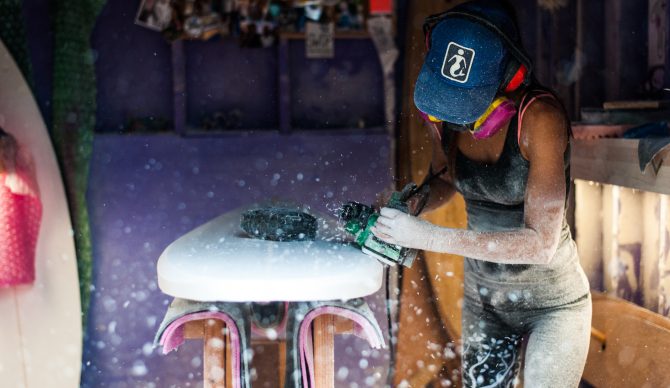
Women are different. They often need different surfboards. Valerie Duprat at work. Photo: Laurent Chantegros
“If most surfboards are made by men, then it stands that most surfboards will be made for men,” wrote Surf Simply’s Lottie Lewis. Quoting the Physiology Journal, she pointed out that males, on average, have proportionately more muscle mass, more bone mass, and a lower percentage of body fat than women. So, she theorized, surfboards designed for men to achieve optimal performance will not necessarily do the same for women.
It’s a theory that’s tough to argue with. And more relevant as the growth of the number of women surfers accelerates. “Women now make up between 20 to 30 percent of surfers, and that number continues to grow,” Lauren Hill, wrote in the foreword to her book, She Surf.
The number of surfboards designed for women is nowhere near that fraction. It seems madness that a solid chunk of the surfing population may be riding equipment that is, at best, neutral or at worst holding them back from surfing better. Sort of like most surfers riding pencil-thin thrusters in the ’90s.
“For the elite CT surfers, I think the boards are closer in design and outline as the men, but for general surfers, I think there can be more done to accommodate the different body shapes,” says Dylan Longbottom, of Dylan Surfboards, who shapes boards for Lucas Chianca, Laurie Towner, Laura Enever and Justine Dupont, and his daughters Summa and Malia.
“The feedback I get from the girls is that sometimes a lack of upper body strength affects their paddling power. So a bit more volume is needed under their chest and torso to compensate for that. I also try to make the boards a little more forgiving, just subtle changes, especially in the beginner to intermediate range.”
It is true that at the very pointy end of high-performance surfboards, the differences between men and women are compressed. Back in 2015, Matt Biolos stated that his team riders Kolohe Andino and Carissa Moore practically rode identical boards. Steph Gilmore rode Mick Fanning DHD models, all be it with less volume, to four of her World Titles.
The prevailing theory was that surfboards were unisex. Now, that seems fanciful at best. Or an orthodox generated by the fact that almost all shapers were men, as were most of their customers. The good news is that it is changing.
“I have a catalogue with six high-performance models, and the feedback I have from the girls is that the surfboards that work the best have more rocker and less concave,” says Johnny Cabianca, of Cabianca Surfboards, who shapes Gabriel Medina’s boards. Cabianca’s observation was that his younger female team riders tend to be taller, but with less leg strength than their male counterparts. He also thinks they tend to push on the front and back feet equally, whereas the boys are more back-foot orientated. “The combo of more rocker and less concave seems to suit the different way they approach the waves,” he says.
Away from the high-performance end, there is huge ground needed to be gained in providing individual models specifically for women. It might be reductive, but the thought of women wearing men’s wetsuits is absurd. Surely, the increased numbers have added a commercial imperative.
“We were getting more and more enquiries from female surfers looking for their perfect board. This would invariably mean a custom order on an existing model that involved maintaining length, but reducing overall volume and refining the details on the board,” said Yasmin Edney, from the UK’s Boardshop. “So (our) idea for Siren Surfboards was born – a range of stock boards tailored to the specific requirements of this new generation of women surfer.”
View this post on Instagram
Another aspect that would help is more female shapers. A 2021 piece on The Inertia highlighted some of the best modern female shapers. And while Whitney Lang, Kat Mortimer, Christine Brailsford Caro, Valerie Duprat, Cher Pendarvis, Kelly Connolly and Ashley Lloyd are inspirational, the sample size remains scandalously small.
“The more I learn about my boards and the way they work the better surfer I will be. And by making the boards myself, it’s probably the best way to improve,” Summa Longbottom said. Summa, Dylan’s oldest daughter has been doing a shaping apprenticeship under her old man in between spending the last few years charging the world’s heaviest slabs.
“There’s not a whole lot of female shapers out there and at first that was daunting,” conceded Summa. “But I’ve had so much encouragement from so many people and I’m so lucky to have a dad who has a surfboard factory.”

Summa, learning from dad. Photo: Billabong
“I think a female shaper can relate better to the women surfers,” chimed in Dylan. “They understand the different body shapes and the way they surf and that has to help progress their surfing. It’s a harsh, physically tough and male-orientated environment, but we need more female shapers in the bay. The market is huge.”
That, however, will be a slow process. There’s no fast track to becoming a good shaper. In the interim, we need existing shapers to look at how surfboards for women can be improved. That should add to the range of stock models designed for women’s different surfing needs.
“We need to make surfing more accessible and inclusive by offering surfboards designed for the smaller, lighter weight surfer,” concludes Siren Surfboards Edney. That doesn’t seem like too much to ask, right?

